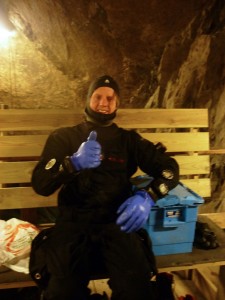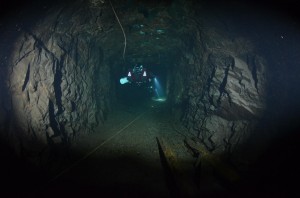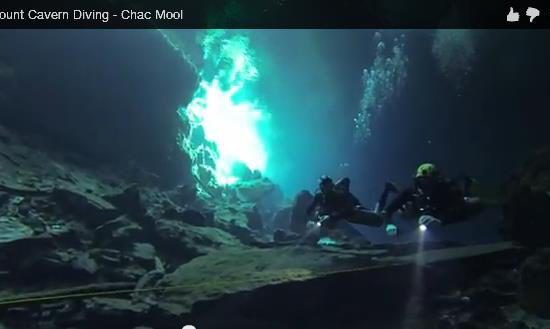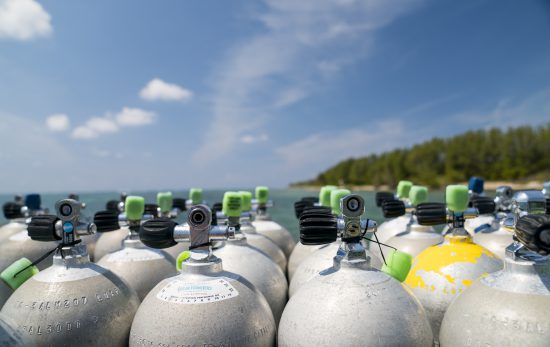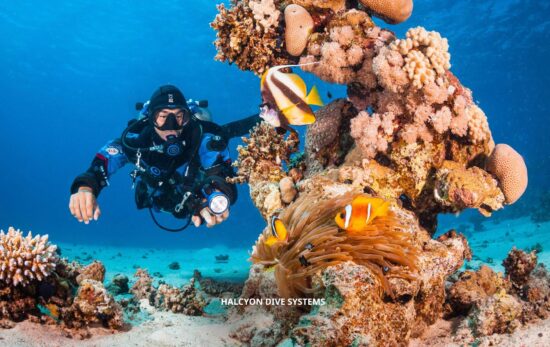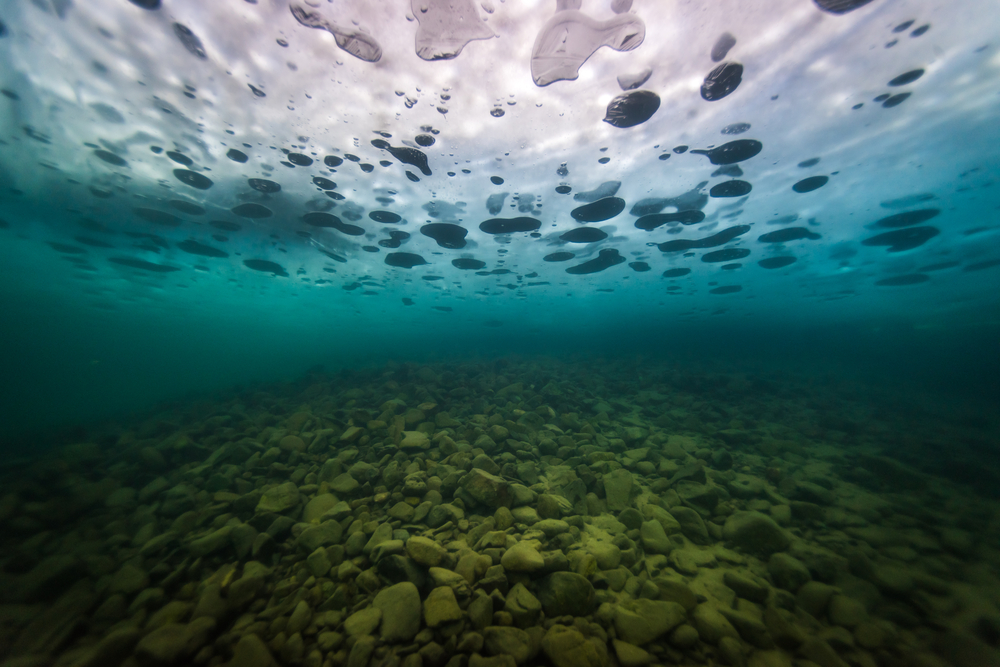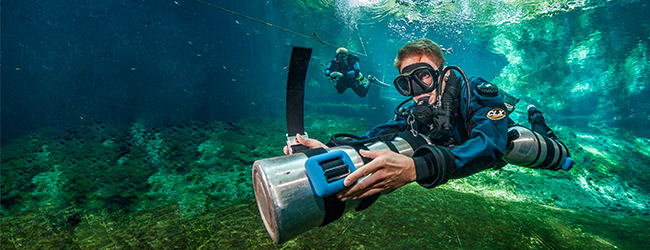Mine Diving in Sweden
By Guest Blogger Chris Haslam
Photos by Patrik Pdyk Juhlin and Chris Haslam
Nearly one year ago I set off for another diving adventure around the globe leaving behind my home turf of Cairns, Australia. It is a slow journey taking me to the many spectacular diving locations this planet has to offer. I had a vision to promote international diving, quality courses and conservation (its still an ongoing project). Via Amed, Bali I have traveled to Egypt where I spent 4 months in this technical diving mecca diving with team mates Team Blue Immersion Dahab, to a depth of 177m (article to follow), to the cooler waters of Sweden. I had left the sun, palm trees and coral reefs to experience an entire winter season of cold water diving.
Many people don’t think of Sweden as a place of good diving, but I will soon put these thoughts to rest. I knew Sweden had good diving but I never knew it was this good. Sweden offers a great diversity including plenty of well preserved wrecks, spectacular fjords, lakes and mines for both the recreational and technical diver. I guess many are put off by the cold water but with the right exposure suit and guidance it doesn’t take long before you are taking full advantage of cold water diving and you too might be happily surprised by its offerings. I have enjoyed it so much I have obtained a working visa and started working towards my project World Dive Team to share my experiences with others. I will make Sweden my base for the next year exploring the waters around Scandinavia while making dive trips abroad. It has been a slow process of diving all over Scandinavia, meeting many locals and picking up much needed advice on different dive locations. The locals have been more than helpful and become good friends supporting my diving adventures. In this article I will share with you a unique style of diving and in particular mine diving in Tuna Hästberg.
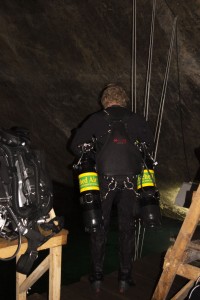
On a mountain above the small village of Tuna Hästberg lies a unique and different world. Deep beneath the earth’s crust lies miles of tunnels with crystal clear water and world class mine diving. Tuna Hästberg is an old iron mine located about 3 hours from Stockholm, Sweden’s capital and nearby to the bigger towns of Borlänge and Ludvika. Mining activities were halted in the late 1960’s and since have left many miles of shafts to be water filled and dived by both local and international cave/mine diving enthusiasts. The 5 ½ hour drive to Tuna Hästberg from my new home in Strömstad (another area surrounded by excellent diving) is spectacular, winding through endless pine forests covered in white snow. We arrive at the mine early morning in -20degrees (brrrrr) and all our gear is transported by trolley and electric winch some 80 metres below ground level. We are equipped with a light and hard hat and make our way down the 400+ stairs at 45degree angle into the pitch black. We then used trolleys to transport our gear through one of the many mine shafts to reach our water entry point. It is at this point you start to realise the adventures diving can take you on.
Diving in an overhead environment requires additional training to promote safety, comfort and enjoyment, although this mine also caters for the Open Water Diver with large passages in open environments. The locals offer the advice needed to safely dive the mine and recommend routes to follow depending on your experience. Permission to dive the mine has to be pre arranged where they check your diving experience and qualifications and arrange guides for those needing. The mine is diveable all year round with constant waters temperatures between 2-4degrees. Avid Swedish tech divers often dive here during the winter months when wreck diving is not as assessable, to keep their skills fresh. At water level the mine is equipped to make diving in this once harsh environment as comfortable as possible with a heated room for relaxing between dives and a compressor, power and maintenance room. An electric cable is used to lower the gear down a further 10m drop to the entry/exit platform while the divers use the step ladder.
Check out this amazing gallery of pictures:
[wzslider]Once in the water it does take a couple of minutes to acclimatize your face to the cold (often feeling like a “brain freeze” when eating ice cream to fast) before heading off to explore this enormous system of tens of kilometers of passages in all directions and levels. There are several kilometers of line laid for the experienced diver at different levels from 10m all the way down to 100m plus (which tech divers do dive and also explore undived territory). There is a deco bar at 6m just beside the entry/exit platform where emergency oxygen is also located. Also not far from this is a habitat in an air pocket of the mine equipped with seats and a fresh supply of air to make deco time more efficient and comfortable. Along the passages there are many well preserved relics, wooden structures, wagons and rooms. During our weekend we made 4 dives. The first day was used as a warm up and to become familiar with my new diving buddies and environment.
Before the beginning of each dive, teams discussed and finialised their plan. Using a whiteboard with a map of the line systems we signed what route we would be navigating and our maximum dives times. For our first dive we planned a shallow route to a spot called “work place” via the “small loop” and set a maximum dive time of 50 minutes. After gearing up, we jumped into the water, performed our safety drills and bubble checks and then began our dive. Close to the entry point we passed the man made habitat, which we would use on day 2 for our decompression. We kept on the main line and eventually came to a T-junction, one way led to the small loop and the other way led to the workplace. We placed a cookie on the side we came from and then went on towards the small loop. Where the loop began we placed another cookie, again to show which way we came from, and then completed the circuit in a few minutes. On the loop, among other cool stuff, we passed a small house. When the loop was completed we went on towards the work place and when we got there, we had only a few minutes to look around the area before we reached our turn pressure. The maximum depth for the dive was 25m, but most of the dive was at a depth of approximately 10m.
After some food, warm beverages and a rest in the heated room we were ready to conduct our second dive of the day, this time heading for “1st wagon”. After setting off through a minor restriction, we placed a jump and connected with another primary line some depth below us, it was really a maze of passages and lines. We followed the new line to a smaller tunnel and found the wagon just inside the entrance. Next to the wagon further into the tunnel laid two work gloves which made me think of the workers working the mine many years ago. When passing through the small tunnel one could clearly see the reflection of the diver in front due to the air in the ceiling making a metallic like mirror which was created by bubbles. Maximum depth for this dive was 33 m.
After a successful and enjoyable first day of diving we left the dive gear at water level and began our journey back to the surface. Accommodation was provided in an old nearby school, which had all the necessities; shower, toilet, heating and kitchen. During the night all our group of 16 divers shared diving stories, pictures and videos.
The next day we took a more adventurous route. For the first dive of the day, we decided to head through a tight restriction called “rabbit hole” and towards our objective of locating the railway switch lever. This was no doubt the most challenging dive yet on this trip. We went up and down along wooden ladders as we made our way through the mine system. The minor restriction “Rabbit hole” was just big enough to let a diver wearing double 18´s squirm through. After passing several T-junctions, leaving a cookie before every one, we finally reached the railway shift lever. At this point we also reached our turn pressure for the dive which dictated it was time to go back. For this kind of diving it is really true that the joy is in the journey! Maximum depth for this dive was 32 m.
The goal for the last dive was to visit what is definitely the most famous dive location in Tuna Hästberg – “östra, västra” (east, west) and “elcentralen” (the electricity station). On the way there, we passed a five way junction which reminds you how complex these mine systems can be to navigate and why proper training is a must. Östra, västra is a sign showing the two available directions at that point in the mine. Behind the sign is a shaft leading further down the mine which is part of the main shaft we walked down to enter the mine, people have dove past 100m into this shaft.
After checking out the shaft we went to a building which is the electrical station. One by one we entered the small building and made a helicopter turn, while looking at all the electrical gadgets and switchboards. At a depth of about 35m using a lean nitrox blend, deco builds up quite quickly, so we soon had to leave for our decompression stops. For our 15 minute deco obligation at 6m it was very convenient to enter the air filled habitat with party lights and comfortable benches. It was here we reflected on what a cool and unique trip of diving it had been.
IMPORTANT – Always make sure you have the correct training and equipment for a dive and most important of all get a local guide with knowledge to make your adventure safe and enjoyable.
Read more about Swedish dive sites
If you want to follow Chris’s adventures or interested in getting involved his details are below.
Chris Haslam Is a PADI MSDT, TecRec, TDI and TXR instructor and Hollis Brand Ambassador.
Facebook: facebook.com/TBISweden
